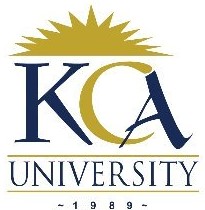 UNIVERSITY EXAMINATIONS: 2011/2012
UNIVERSITY EXAMINATIONS: 2011/2012
YEAR II EXAMINATION FOR THE BACHELOR OF SCIENCE IN
INFORMATION TECHNOLOGY
BIT 2208 PRINCIPLES OF DATA COMMUNICATIONS
DATE: APRIL 2012 TIME: 2 HOURS
INSTRUCTIONS: Answer Question One and Any other Two Questions
QUESTION ONE (COMPULSORY)
a)Define the term “communication system” as it relates to data communication. [1 Mark]
b) State the causes of the following errors and how to prevent them.
(i) White noise [2 Marks]
(ii) Crosstalk [2 Marks]
(iii) Attenuation [2 Marks]
c) Discuss briefly any three (3) factors that one should consider when choosing a transmission
medium. [3 Marks]
d) A periodic signal completes one cycle in 0.001 s. What is the frequency? Show your workings.
[3 Marks]
e) Why is error-correction rarely used in data communication networks? [4 Marks]
f) (i) Distinguish between a Layer 2 switch and a layer 3 switch. [2 Marks]
(ii) Differentiate half-duplex from full duplex. [2 Marks]
g) Briefly explain “Signal spectrum” and “Cost and Complexity” as factors that can be used to
compare various encoding schemes. [4 Marks]
h) A mobile phone connects to the service provider for communication purposes be it audio,
images, etc. Discuss the components that make up the communication system if one person
makes a phone call to another person in a different mobile network. [5 Marks]
QUESTION TWO
a) Briefly discuss the two (2) short-comings of asynchronous transmission. [4 Marks]
b) List and discuss any three (3) causes of late collisions in computer networks. [6 Marks]
c) State two (2) signals that wireless networks use to communicate from one computer to another
without permanent cable connection: [2 Marks]
d) Describe how TCP implements congestion control [4 Marks]
e) Describe two problem areas associated with the use of the Internet to interconnect private
networks. [4 Marks]
QUESTION THREE
a) List four (4) uses of the OSI reference model [4
Marks]
b) Differentiate between:
i. Distance Vector and Link State routers [2 Marks]
ii. Cut-through switching and store-and-forward switching [2 Marks]
c) Discuss “Performance” and “Reliability” as two criteria used to evaluate data networks.
[3 Marks]
d) Differentiate between “Polar” and “Bipolar” as they relate to encoding. [4 Marks]
e) Describe the half-duplex (CSMA/CD) access method. [5 Marks]
QUESTION FOUR
a) With the aid of relevant diagrams using the bit stream provided, describe the following:
1 1 0 1 1 0 0 0 1 0 1
(i) Amplitude modulation (AM) [2 Marks]
(ii) Frequency modulation (FM) [2 Marks]
(iii)Phase Modulation (PM) [2 Marks]
b) Encode the bit stream provided in (a) above using the following encoding schemes:
(i) Non-Return to Zero Inverted [2 Marks]
(ii) Bipolar AMI [2 Marks]
(iii) Differential Manchester [2 Marks]
c) Distinguish between backward error correction and forward error correction. [4 Marks]
d) Define Congestion as it relates to data communication. [2 Marks]
e) Describe briefly the concept of a message-passing system. [2 Marks]
QUESTION FIVE
KCA University has campuses in Kisumu, Nairobi CBD and Main campus at Ruaraka. Each campus
runs an independent LAN from other campuses. In the recent past, the University has experienced a lot
of growth in these campuses and a need to review the current set up of the networks has arisen.
Kisumu campus has an average of 400 computers, EcoBank Towers has approximately 500 computers
and main campus has 800 computers besides 1200 laptops. As an expert in Data and Computer
Networks :
a) Describe the possible ways in which you can connect the three campuses. [6 Marks]
b) List and describe the networking and internetworking equipment you will deploy in setting up
the network. [4 Marks]
c) Discuss how you would implement wireless technologies to assist in future expansions of the
network. [6 Marks]
d) Identify and briefly discuss any two (2) possible challenges that this private network is likely to
experience. [4 Marks]